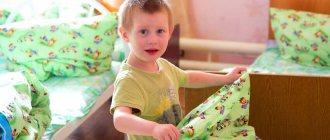Peculiarities of work activity of preschool children
It is important for adults not to miss the moment when children want to work and participate in household chores. This desire awakens in preschool age. With competent support, adults will be able to strengthen interest in work, while removing the child from work will gradually discourage him from wanting to work physically.
Why do mothers, fathers, and grandmothers often prefer to prohibit a child’s participation in any activity rather than support it? The reason is either increased anxiety for the child - lest he hurt himself, lest he harm himself while trying to manipulate the mop, reach the faucet, etc. Or adults are dissatisfied with the child’s inept actions, after which there will be even more washing and cleaning.
But you will have to come to terms with these moments if adults understand their own responsibility for instilling hard work in their little helper.
A characteristic feature of the work activity of a preschooler is that the child is focused not on a quality result, but on the immediate process. At preschool age, the need to take part in real life and be involved in the world of adults becomes actualized. This need can be realized by getting involved in specific activities.
This need is only partially realized in gaming activities. Children often simulate adult life in story-based games. But they understand that this is “make-believe.” And young people want real participation in real things that they observe every day at home or in kindergarten.
In labor, the child gets the opportunity to independently perform those actions that he previously only observed. By making efforts, the child believes that he, like an adult, is useful. That is why work activity is so attractive in preschool age.
Motives that encourage children to work
The motivation to put in work effort changes as the preschooler grows up. Motive is a structural component of any activity. Along with operations, it shapes the labor process from an early age. Other components of the work activity of preschoolers appear later.
Three- to four-year-old children are motivated by interest in the process itself. It’s so interesting to stir a ladle in a pan or move it with a vacuum cleaner brush.
In middle preschool age, children are pushed to do feasible work by incentives and reprimands . For example, a child is happy to wipe cutlery because his mother praises what a wonderful helper he is. In the same way, a preschooler quickly puts his toys in order, because after cleaning, dad promised to read a book together. Or the child independently begins to put together the scattered parts of the construction set so that his mother does not scold him.
The highest level in preschool age is social motives for work . Guided by these motives, children move from performing exciting actions or things for which they expect praise to actions that are important to other people.
Making a craft as a gift for mom, helping grandma water the garden bed, putting on shoes and tying shoelaces for a younger sister are examples of things that older preschoolers do in an effort to show concern for loved ones. In such cases, the question of whether the immediate process is interesting is not considered. The child realizes the value of his labor participation for the benefit of others. This is the right period to decide what the child should do around the house to help his parents.
SELF-CARE: Tasks and content of work in groups
1st junior group
1. To develop in children the ability to take care of themselves independently (while undressing, dressing, washing, eating).
2. Continue to teach children under the supervision of an adult, and then wash your hands yourself when they become dirty and before eating, wipe your face and hands dry with a personal towel.
3. Learn to put yourself in order with the help of an adult.
4. To develop the skill of using individual objects (handkerchief, napkin, towel, comb, pot).
5. Encourage children to be independent when eating, teach them to hold a spoon in their right hand.
6. Teach children how to dress and undress.
7. Learn to take off clothes and shoes (unfasten front buttons, Velcro fasteners) with a little help from an adult.
8. Learn to carefully fold removed clothes in a certain order.
9. Learn to put on clothes and shoes correctly.
2nd junior group
1. Continue teaching children to dress and undress independently in a certain sequence (putting on and taking off clothes, unbuttoning and fastening buttons, folding, hanging clothes, etc.).
2. Develop neatness, the ability to notice disorder in clothing and eliminate it with a little help from adults.
3. Continue to teach how to use soap correctly, carefully wash your hands, face, ears; Wipe yourself dry after washing, hang the towel back, use a comb and a handkerchief.
4. Learn to use tablespoons, teaspoons, forks, and napkins correctly.
Middle group
1. Improve the ability to dress and undress independently; teach to neatly fold and hang clothes with the help of an adult, put them in order - clean, dry
2. Cultivate the desire to always be neat and tidy.
3. Cultivate the habit of washing yourself, washing your hands before eating, when dirty, and after using the toilet.
4. Strengthen the ability to use a comb and handkerchief.
5. When coughing and sneezing, teach people to turn away and cover their nose and mouth with a tissue.
6. Continue to teach how to use cutlery correctly - spoon, fork, knife).
7. Learn to rinse your mouth after eating
Senior group
1. Form the habit of brushing your teeth and washing your face every day, and washing your hands as necessary.
2. Strengthen the ability to dress and undress independently, carefully put clothes in a closet, dry wet things in a timely manner, care for shoes (wash, wipe, clean, put away).
3. Learn to notice and independently eliminate disorder in your appearance.
4. Form the habit of taking care of personal belongings.
5. Develop a desire to help each other
6. Train yourself to brush your teeth and keep your nails clean.
7. Maintain order in your closet, put clothes in certain places
8. Learn to make your bed neatly
Preparatory group
1. Strengthen the ability to dress and undress independently in a certain sequence, correctly and neatly put clothes in the closet, put shoes in place, dry wet things in a timely manner, care for shoes (wash, wipe, clean).
2. Learn to notice and independently eliminate problems in your appearance, tactfully tell a friend about a problem in his suit or shoes, and help eliminate it. Develop qualities such as responsiveness and mutual assistance.
3. Learn to independently prepare materials and manuals for the lesson
4. Get into the habit of brushing your teeth, rinsing your mouth after eating, and washing your feet before going to bed.
By the end of the year, children can: dress and undress, keep their clothes in order, and, if necessary, put them in order.
ON A NOTE. Educational toys for kindergarten at low prices from a specialized store for teachers “Kindergarten” - detsad-shop.ru
Organization of work activities of preschool children
Work activities throughout preschool childhood become more complex, covering the path from mastering self-service skills to performing household duties and caring for plants and pets.
At 3-4 years old, even brushing your teeth or getting dressed for a walk on your own is difficult. With the development of manual skills, children's self-service skills are automated and move from the category of “work” into everyday actions. The work activity of a preschooler is filled with other processes involving the development of tools and the achievement of results.
The uniqueness of the work activities of younger preschoolers
It is clear that a 3-year-old child will persistently demand to be allowed to test in the kitchen in order to “help” make pies. But his interest will dry up in response to an offer to tidy up the gaming corner of his room.
The main reason is the lack of novelty, and therefore the lack of excitement in the process. Other, no less important reasons are added to it. The kid may simply not understand how to restore this very order...
In early preschool age, in order to introduce a child to work that is feasible for him, it is important to give specific and understandable instructions. “Put the cubes in a box, put the box on the shelf”, “Put your socks in a drawer” - after hearing such instructions, the baby will understand what they want from him at the moment, and will also gradually form a sequence for putting things in order.
Clear instructions are an essential element in developing a preschooler’s work skills.
Only by mastering the rules that allow him to organize his work will a preschooler be able to independently initiate and complete everyday work activities in the future.
Labor in older preschool age
Older preschoolers are introduced to work not for the sake of participation. Although there are also cases when 6-7 year old children are driven solely by curiosity: “How do you spin that? Let me try.” “I also want to dig” - the child takes up a shovel, but after a few attempts he loses the desire to do something that is quite physically difficult.
However, in most cases, all components of work activity can be traced in the activities of preschoolers: motive, goal, actual actions, control and evaluation . That is, the child sees the goal for applying his efforts, chooses the means, how he can get the result, performs the actions and is interested in the result of his work.
For example, 5-year-old Masha reports that she wants to sweep the room “to make it clean.” Having at least practiced with a broom, she collects the garbage in a dustpan and immediately asks if she swept well. Although the girl relies solely on praise for her efforts, she is interested in achieving her goal.
Mastering the components of work activity contributes to the development of the personal qualities of a preschooler. There is a direct influence on the formation of the following qualities:
- hard work
- responsibility
- independence
- perseverance
- criticality
Older preschoolers evaluate their work more objectively. They notice, unlike younger children, gross shortcomings and try to correct them. But it is important to them how an adult evaluates the quality of their work actions, so they ask appropriate questions.
Thanks to the development of speech, children in older preschool age are well able to perceive verbal instructions on how to perform a certain task. Adults will help the child if together they discuss the sequence of steps that will lead to the desired result.
The meaning of child labor and its types
Developing labor skills in a child is of great importance in shaping his physical and moral development. Children, mastering different types of work, gradually become more confident and physically stronger.
The labor process disciplines children and develops in them a sense of responsibility for themselves and their actions.
The importance of work in the lives of children
The types of labor depend on what the goal is and what the tasks of the labor process are:
- self-care: the child must have basic self-care skills;
- household skills;
- be able to work outdoors;
- manual labor.
Two main tasks of labor education
All types of labor are aimed at ensuring that children can master all the features of the world around them, develop the ability to think, hone their memory, study the purpose and learn to work with different tools, and become familiar with the rules for using materials. Children should master the content of the labor process by following the example of adults, imitating them, and adopting certain labor skills.
By mastering different types of work, preschoolers broaden their horizons and develop respect for their elders.
Socialization of a preschool child in work activity
Work is an effective condition for the socialization of a child. A preschooler watches how other children perform certain labor activities, and he also wants to join such an activity. When doing a task, communication invariably begins. Children love to share advice in the style: “You’re doing it wrong! Look at me!
You can observe how preschoolers exchange tools, testing the better (or worse) the tool of their lesson partner. Carrying out a common task, they learn to negotiate, distribute responsibilities, come up with rules, and control their implementation.
Even in collective work, excellent opportunities are found for developing the skills to control and evaluate one’s own work and the activities of others. The child observes how an adult evaluates the work of other children and perceives evaluative statements as a guide for his actions.
The labor involvement of a preschooler is far from the main one among the activities that children engage in before school. But work plays a crucial role in the moral education of a child, in the emergence of the need to work. Without the timely development of work skills and awareness of the social motives of work, a growing child is unlikely to become a hardworking and responsible person in the future.




